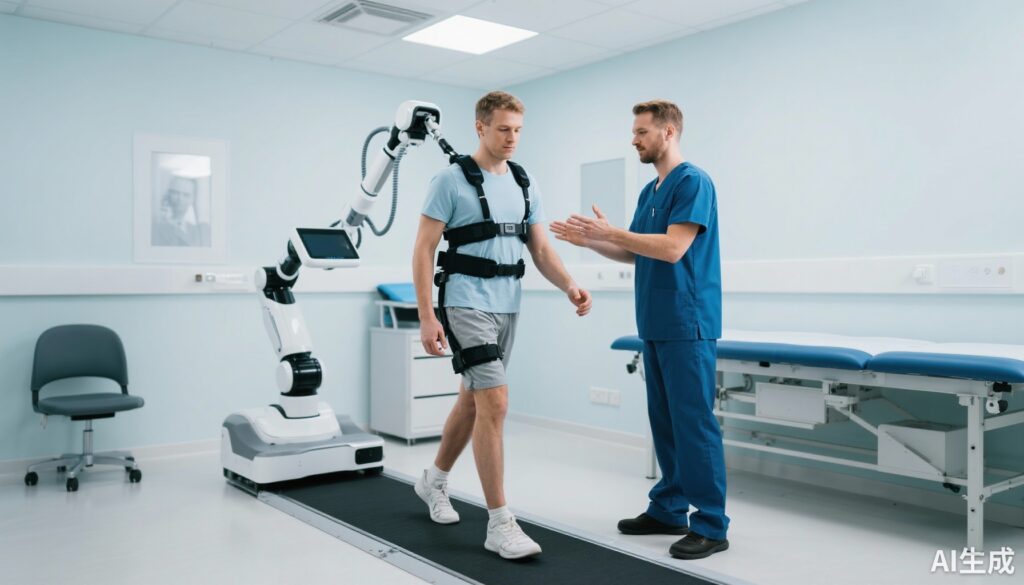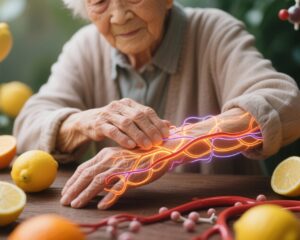Highlight
- Combining high-intensity interval training (HIIT) with robot-assisted gait therapy (RAGT) significantly improves gait speed, balance, and motor function in chronic stroke patients compared to treadmill gait therapy alone.
- The intervention group showed improved 10-meter walk test times, Functional Ambulation Category scores, Berg Balance Scale, and lower extremity motor scores with large effect sizes.
- Enhanced aerobic capacity (VO₂max) and walking endurance (2-minute walk test) were observed in the HIIT plus RAGT group, supporting cardiovascular benefits of this combined strategy.
- Lean body mass changes were minimal in both groups, indicating functional improvements were not attributed to muscle mass increase.
Study Background and Disease Burden
Stroke remains a leading cause of long-term adult disability globally, with up to 50% of survivors experiencing significant gait and balance impairments that limit mobility and quality of life. Chronic stroke phases present challenges in rehabilitation due to neural and muscular deficits that persist beyond spontaneous recovery windows. Improving ambulatory function is paramount, as it directly influences independence and social participation. Traditional rehabilitation strategies, including conventional treadmill training, offer modest improvements but may lack intensity or task specificity to maximize neuroplastic recovery.
Robot-assisted gait therapy (RAGT) has emerged as a promising modality delivering intensive, repetitive, and task-specific gait practice. RAGT devices enable standardized, supported walking practice with potential to promote motor relearning. Concurrently, high-intensity interval training (HIIT)—characterized by alternating bouts of moderate and high-intensity exercise—has demonstrated cardiovascular and motor benefits in stroke rehabilitation by enhancing aerobic capacity and muscle endurance.
Despite evidence supporting each modality individually, their combined efficacy remains underexplored. This study by Kim et al. addresses a critical gap by evaluating whether integrating HIIT with RAGT yields superior improvements in gait, balance, and lower limb function compared to conventional treadmill gait therapy in patients with chronic stroke.
Study Design
This randomized controlled trial recruited 48 ambulatory patients with chronic stroke (>6 months post-event), carefully screened for eligibility.
Participants were randomly assigned to two groups:
– Control: Treadmill-based gait therapy
– Intervention: Robot-assisted gait therapy (RAGT) combined with high-intensity interval training (HIIT)
Key intervention parameters:
– Duration: 30 minutes per session
– Frequency: Three sessions per week
– Duration of intervention: 8 weeks
– HIIT protocol involved alternating periods of moderate and high intensity during gait sessions using an end-effector robot system.
Outcome measures evaluated pre- and post-intervention included:
– 10-meter walk test (10MWT) for gait speed
– Functional Ambulation Category (FAC) for walking independence
– Berg Balance Scale (BBS) for balance
– Fugl-Meyer Assessment- Lower Extremity (FMA-LE) for motor recovery
– Two-minute walk test (2MWT) for walking endurance
– VO₂max for aerobic capacity
– Modified Barthel Index (MBI) for activities of daily living
– Lean body mass to assess muscle mass changes
Key Findings
The study achieved excellent retention with 44 (91.7%) patients completing the protocol.
Comparative analysis revealed that the HIIT plus RAGT intervention group experienced statistically and clinically significant improvements across multiple functional domains:
Gait Speed and Autonomy
– The 10MWT showed a robust improvement favoring the intervention group (p < 0.001) with a large effect size (d = 1.2), indicating meaningful acceleration in comfortable walking speed.
– The FAC scores improved significantly (p = 0.009), reflecting enhanced walking independence.
Balance and Motor Function
– BBS scores increased significantly in the intervention group (p = 0.015), suggesting better postural stability.
– The FMA-LE, a validated lower limb motor function scale, showed marked gains (p < 0.001), indicating motor recovery.
Walking Endurance and Aerobic Capacity
– The 2MWT improved significantly between groups and within the intervention group (p = 0.005; p < 0.001 respectively), demonstrating enhanced endurance.
– VO₂max increased substantially (p = 0.005) only within the intervention group, highlighting aerobic fitness benefits likely attributable to the HIIT regimen.
Activities of Daily Living and Lean Mass
– No significant between-group differences in Modified Barthel Index scores were noted, possibly reflecting that the focus was primarily on gait and motor outcomes rather than broader functional independence.
– Lean body mass showed only minor within-group changes, indicating that neuromotor and aerobic improvements were not primarily from increased muscle mass.
Overall, these findings underscore the synergistic potential of combining HIIT with RAGT to promote neural plasticity and physical conditioning, translating to clinically meaningful functional gains.
Expert Commentary
The integration of HIIT into robot-assisted gait therapy provides a novel rehabilitation paradigm that aligns with principles of motor learning and cardiovascular conditioning. The intensity and task specificity enabled by RAGT, augmented by aerobic challenge via HIIT, may stimulate sensorimotor networks more robustly than conventional treadmill therapy.
While this study’s results are promising, certain considerations remain. The relatively short 8-week intervention limits long-term efficacy assessment; sustained functional gains and cost-effectiveness analyses are warranted. Additionally, generalizability may be constrained to ambulatory patients with moderate impairments as severely disabled patients were likely excluded.
These findings resonate with evolving rehabilitation guidelines emphasizing individualized, intensive, and multimodal gait training post-stroke. Mechanistically, the repeated high-intensity practice may enhance cortical reorganization, cardiovascular endurance, and muscle activation patterns synergistically.
Further large-scale, multicenter trials including diverse stroke populations and longer follow-ups are needed to consolidate evidence and optimize therapeutic protocols.
Conclusion
This randomized controlled trial provides compelling evidence that combining high-intensity interval training with robot-assisted gait therapy significantly improves gait speed, balance, motor function, and aerobic capacity in patients with chronic stroke compared with treadmill gait training alone.
The findings highlight the potential of intensive, repetitive, task-specific, and aerobic-integrated rehabilitation strategies to maximize functional recovery and quality of life in this growing patient population.
Adoption of this combined approach could represent an important advance in post-stroke neurorehabilitation, meriting further clinical adoption and investigation.
References
1. Kim J, Do J, Bae CR, Mo YH, Kim JH, Kim DY. High-intensity interval training with robot-assisted gait therapy vs. treadmill gait therapy in chronic stroke: a randomized controlled trial. J Neuroeng Rehabil. 2025 Aug 2;22(1):173. doi:10.1186/s12984-025-01674-0. PMID: 40753404; PMCID: PMC12317475.
2. Dobkin BH. Neurobiology of rehabilitation. Ann NY Acad Sci. 2009; 1142:243-255.
3. Tang A, Sibley K, Thomas S, et al. Robot-assisted gait training compared with conventional gait training in patients with subacute stroke: a randomized controlled trial. J Rehabil Med. 2021;53(9):jrm00103.
4. Billinger SA, Arena R, Bernhardt J, et al. Physical activity and exercise recommendations for stroke survivors. Stroke. 2014;45(8):2532-2553.
5. Ivey FM, Hafer-Macko CE, Ryan AS. Exercise rehabilitation after stroke. NeuroRx. 2006;3(4):439-450.



